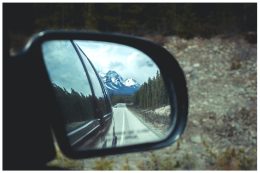Ice Climbing 101: Where to Start

For rock climbers, ice climbing is the perfect way to extend the outdoor season through those cold, icy months. For the rest of us adventure-seekers, it’s a thrilling opportunity to scale frozen waterfalls and learn to swing an ice axe. You’ve seen the photos, it looks epic! And, while it may seem a little intimidating, ice climbing is a beginner friendly sport if you start out with the right knowledge. Welcome to ice climbing 101.
PSA: This blog is not intended to be a step-by-step guide or a suggestion to try the sport alone. Always go with a guide when you’re learning the ropes.
What is Ice Climbing?
Ice climbing is similar to rock climbing, except it takes place on ice. And involves different techniques. And has different gear. So, actually, there’s plenty to get familiarized with!
This type of climbing can happen independently (often in isolated, roped off sections of waterfall) or on a mountain expedition where a variety of different traversing techniques are being used. Versatile and experienced ice climbers often mix multiple types of climbing on their expeditions (rock, ice and snow). Ice climbing is considered an extreme sport due to the nature it occurs in, but that doesn’t mean it’s an inaccessible sport! Going with a guide will help introduce you to the basics within a safe learning environment.
Who Is it For?
Anyone with a sense of Adventure!
Seasoned explorers and beginners alike, this sport is suitable for all. You’ll need a good level of fitness to be able to carry your gear as you climb, but coming with an enthusiastic attitude will give you the biggest advantage.
Yervana Local, Jeff, is a seasoned ice climber based in Banff. On sharing how he was initially drawn to the sport, he said “it was a product of need more adventure, and I loved rock climbing so why not?”
Ice climbing “maintains climbing fitness year round” he says. “After 25 yrs I still enjoy it, and it’s very satisfying to teach keen beginners to get them the right information on all of the aspects of the sport.”

What to Expect
A truly satisfying experience! Climbing nurtures the mind while pushing the body. Ice climbing involves learning interesting body movements within dynamic environments, and swinging an axe feels good for everyone!
Local ice climbing guide Jeff, gives added assurance for first timers. On your first session you can expect “a safe, educational approach, with a very experienced guide and high end gear- which is included!”.
How to Start Ice Climbing
Although ice climbing is a beginner friendly sport, it shouldn’t be attempted without a knowledgable guide. Head out with a local, certified guide in your area of interest to stay safe and find the best spot for your skill level. If you’re looking at travelling to Banff, Canmore or Jasper to ice climb, we’ve got the guides for you. Yervana works with certified ACMG/IFMGA mountain guides to ensure you’re in safe hands as you learn to ropes and get to grips with the ice.
Where and When to Try Ice Climbing
Ice climbing can technically be done year-round (hello glaciers!). But most climbers will practice rock climbing during the summer months and head back to the ice as soon as winter hits from around December to March.
In Western Canada, we have an abundance of destinations to get started. Mountain towns and their surrounding areas are a great spot to experience ice climbing. This includes Banff, Canmore, Squamish and Whistler.

Know Your Gear
Like rock climbing, you’ll use harnesses, ropes, helmets and belay devices (with a few ice-specific alterations). The big difference comes with the boots, crampons and tools designed for tackling the ice.
Boots:
Some introductory ice climbing tours will include boots in the cost of the adventure. If you’re in the market to buy, visit MEC or your local outdoor store to browse options. You can also rent from a variety of places within mountain towns or cities nearby. Generally, you’ll be looking for warmth, stiff, waterproof, crampon-compatible and ankle flexible boots.
Crampons:
When ice climbing with a guide, crampons will often be included. But, if not, you’ll be basing your decision on what the crampons are made of and what the toe point looks like. Ensure you have the best crampon for your type of environment!
Tools:
Ice tools are NOT the same as mountaineering tools. Again, these often come as a package deal with a guide, but if not, there are a few things you can keep in mind while making your purchase/rental. Make sure you find the shorter pick with a curved shaft. The shape of the ice tool will also be different. It will have a reverse curve: there will be a protrusion at the end of the curve which makes it easier to get the tool out of the ice.
What to Bring
Ice climbing occurs in a cold and intense environment. There’s a reason it’s considered an extreme sport! This means you need to prepare your clothing for the conditions you’ll be climbing in. Make sure you have a warm down or synthetic jacket and pants, warm mitts (for when you’re not on the ropes) and warm, dexterous gloves that assist you while climbing!
If you’re looking for more guidance on winter wear for Canada, you can find it in our blog.
If this sounds like your idea of a sweet winter experience, check out our ice climbing Adventures. Some are located in Banff: one of the top 10 climbing locations in the world!
See you on the ice!







